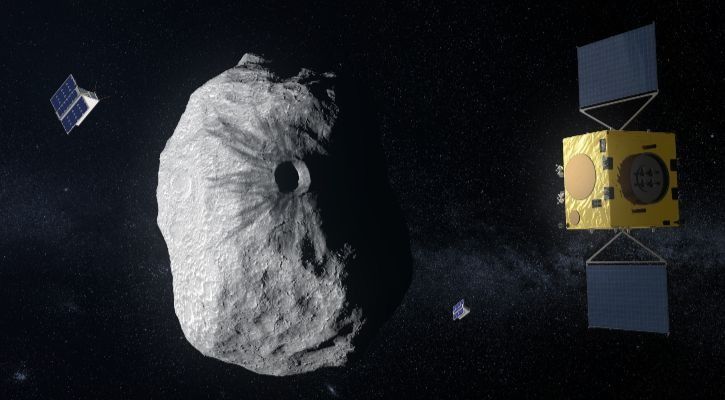

In fact ESA will be launching a follow-up mission called Hera that will visit the system in 2027 and nail down the exact change. This will change its 11.9-hour orbital period by about 10 minutes, which is enough to measure. The impact will change the orbital velocity of Dimorphos by roughly 0.4 mm/sec, a tiny amount indeed. It uses ion engines for fine-tuning the maneuvering.Ĭomparison of the size of the DART spacecraft, the asteroid Didymos, and its moon Dimorphos to various landmarks. It has a handful of sensors to track the stars and the Sun for navigation, and a camera that will image the asteroid and help keep the spacecraft centered on its target. It’s a pretty simple machine as these things go. It’s a boxy spacecraft a little over a meter on a side, so about the size of a big clothes washer - not including the two solar arrays, which are 8.5 meters long. The primary purpose, though, wasn’t to move the comet but to eject enough material to see what was under the surface.ĭART is different. We’ve impacted a space object once before: Comet Tempel 1 with the Deep Impact probe on July 4, 2005. The amount of change doesn’t have to be very big if there’s enough time before impact even a centimeter per second could do the trick, since this could deflect the asteroid by enough to miss us after a few years’ time. If an asteroid is headed toward Earth and we have a reasonable amount of lead time, we can launch a mission with a space probe that can hit the asteroid, hard, and change its trajectory. Astronomers are cataloguing potentially dangerous asteroids, and with rockets there’s something we may be able to do about them.Īnd that’s the reasoning behind the DART mission. The difference between us and the dinosaurs is that we have the science of astronomy and a space program. The DART mission took this image, a composite of 243 separate shots, of the asteroid Didymos and its moon Dimorphos from over 30 million km away on July 27, 2022. Just ask the dinosaurs… which you can’t, for obvious reasons. It can easily dwarf a nuclear weapon, and if the asteroid is big enough it can be larger than the combined nuclear arsenal of every nation on Earth.


They are moving so quickly - dozens of kilometers per second, so in some case more than 100,000 km/hr - that the energy of impact is huge. That’s not necessarily a problem if they’re small, but when they get to around 100 meters in size that spells big trouble. Some, however, have orbits that bring them close to Earth, and, over time, could eventually hit us. 26, 2022, it will be just 11.5 million km from us, 30 times the distance to the Moon.Īsteroids are debris left over from the formation of the solar system, chunks of rock and ice and, in some cases, metal that for the most part orbit the Sun between Mars and Jupiter. On the date of the DART mission impact, Sep. The orbit of the binary asteroid 65803 Didymos brings it relatively close to Earth. There has been some fearmongering over this event, because of course there has, but there’s no truth to it.

The debris created will mostly be dust, and any chunks too small and far away to be a threat. Note : To be clear, the asteroid will be over 11 million kilometers from Earth when it’s hit, which is far too far away to be of any danger to us. The point? To see if hitting an asteroid at high speed is possible, to test the mechanics and engineering of it, and to hope that, if one day we see a space rock with our number on it, this method can be employed to prevent Earth from having a Very Bad Day.
ITS SPACE EYE NASA DART FIRST PROFESSIONAL
It will be observed by professional astronomers across the planet and by observatories above and beyond it, too. The flash won’t be visible by eye, but may be observable in small telescopes - see my caveats below. Impact is planned for 23:14 UTC tonight, which is 7:14 p.m. Tonight, if all goes well, NASA’s Double Asteroid Redirection Test - or DART - mission will slam into a tiny asteroid moon at nearly 24,000 kilometers per hour, blasting out a cloud of debris, creating a flash of light visible across the solar system, and changing the velocity of the asteroid by less than a millimeter per second… which is tiny, but significant.


 0 kommentar(er)
0 kommentar(er)
